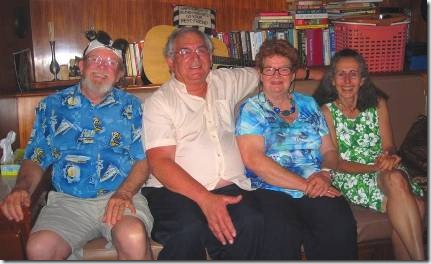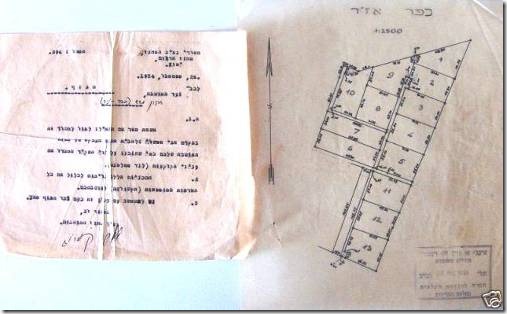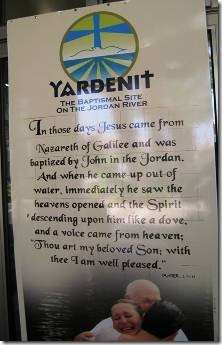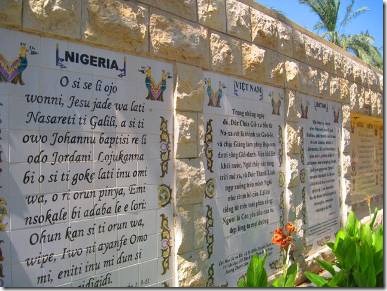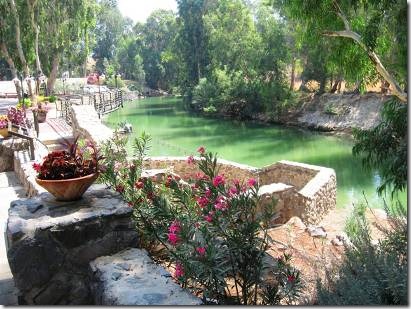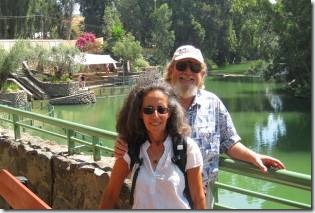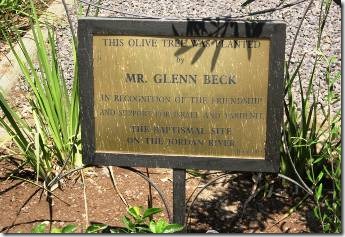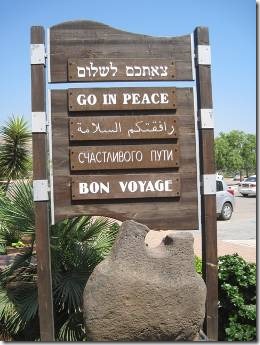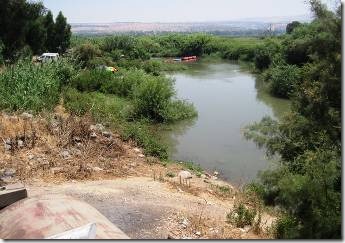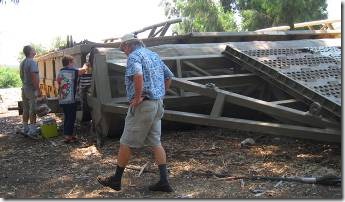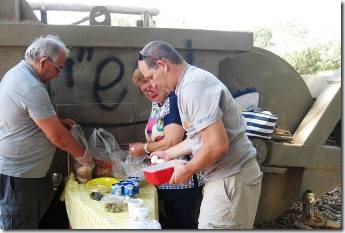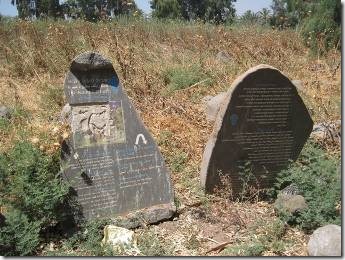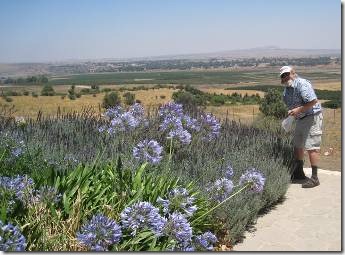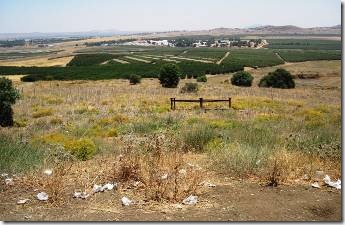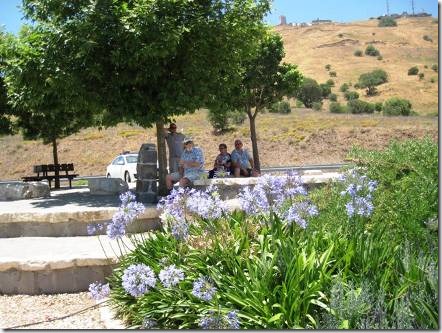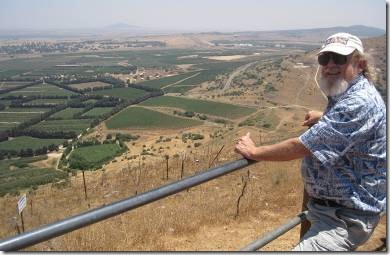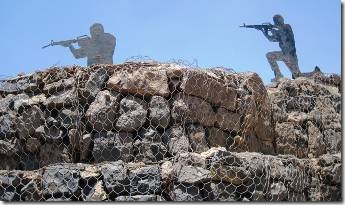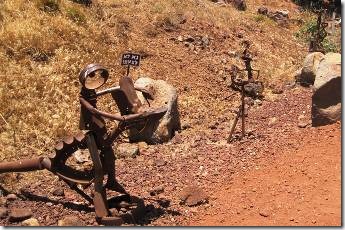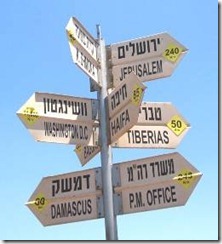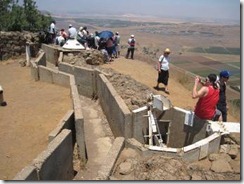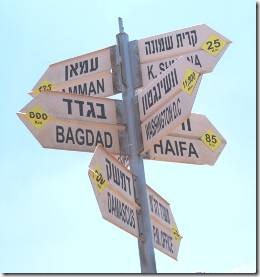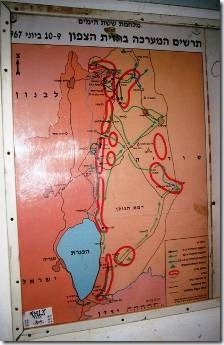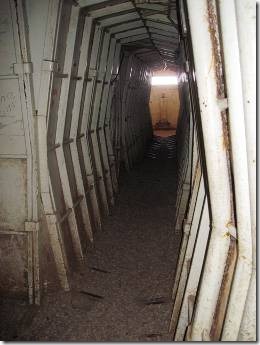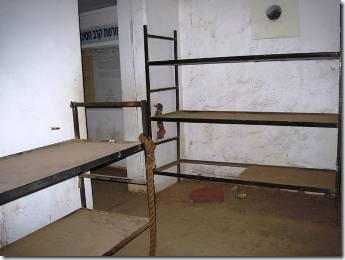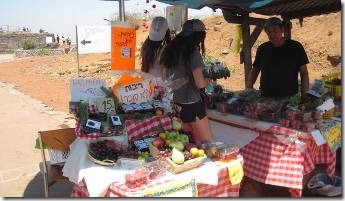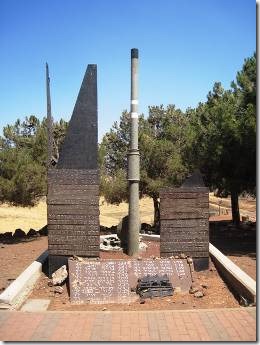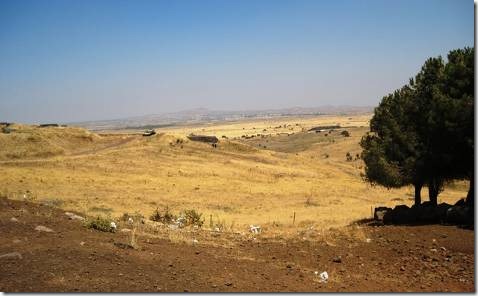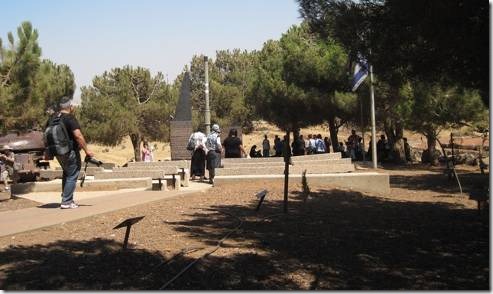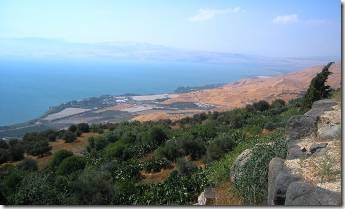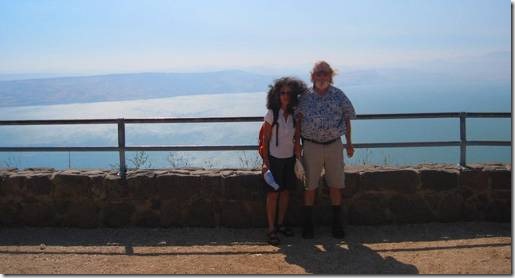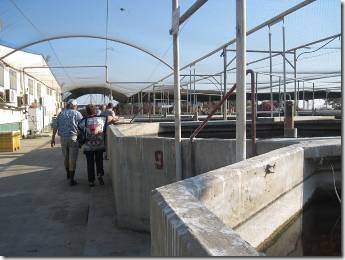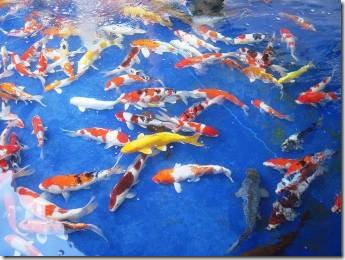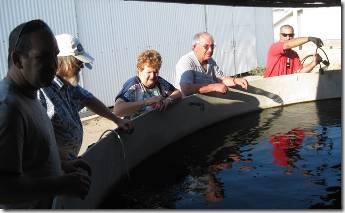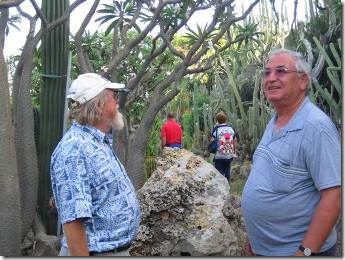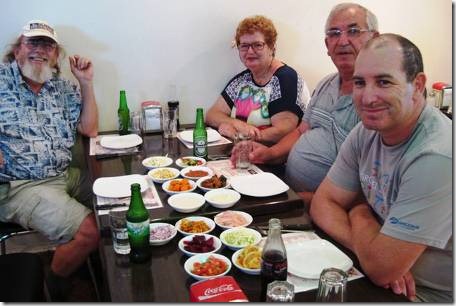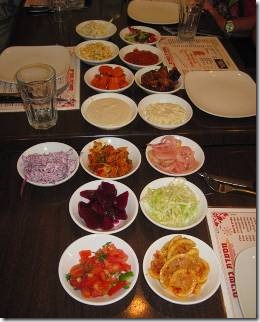Shalom,
We’re just starting to feel more at home here in Israel, and it’s time to leave. Tomorrow when it’s light we’ll leave Ashdod Marina and go the 8 miles to Ashkelon Marina where there are government officials to check us out from Israel. We are heading back to Turkey. Our home for the time we will be there will be Netsel Marina in Marmaris. We spent from May through July 2011 in Marmaris and liked the town. We were "out in the country" at Yacht Marine last time. This time we will be in the city which will be nice.
Our passage to Turkey will take 3 nights. We should arrive in Marmaris July 18th. It will take us a bit to get set up with a phone but hopefully the marina wifi will work so we can announce our safe arrival. I still have lots to write about Israel. I’ll catch up at some point.
This email is about our day touring with Nilly, Eitan and their son Dror.
So for now, Shalom
Ru
Golan Heights with Nilly, Eitan, and Dror (which means freedom)
Some reminder notes from Nilly and Eitan to help me with this blog. So I especially want to say that any mistakes are truly my own.)
"Hi Ruth and Randal
The name of the kibuz is o.k as you wrote. (Kibbutz Ma’agan Michael where we stopped for a quick tour.)
The name of the guide is NITZAN GALPAZ. (Kibbutz Ma’agan Michael guide)
we also stop at cohav yair were dror is living, (Dror is the son of Nilly and Eitan)
In Yardenit, on the Jordan river.
The tank in kibutz DEGANIA
breakfast close to ARIK SHARON bridge.
mount BEN-Tal were cofee anan and the bunker. a view to Cunetra in Sirya, and other side
to kibutz Merom-Golan. ( Cofee Anan is the name of the coffee shop on Mount Bental…a play on the name of Kofi Annan)
the valley of tears and the story of Avigdor Kealany.
We cross the city KAZARIN.
a view on the Kinnert lake from the Golan from the kibuz Kefar-Haruv ( Shalom point of view.
, we drove from HAAMAT-GAder, the border of Syria,Jorden
and Israel (were the Hot spring+spa+Crocodails.
we eat dinner at OR-AKIVA near CEASARIA. (And it was really really good!)
Hope it will help you to remember.
Love
Nilly and Eitan."
You can see how much we crammed in so I might be forgiven for mixing up a few things.
You met Nilly and Eitan Bukchin in a earlier email.
On DoraMac in Herzliya
Nilly, Eitan and their son Dror Bukchin love their country. They don’t think everything about Israel is perfect, but they love it and have fought for it…..literally! More about all that later. Knowing our time in Israel was coming to an end, and that we hadn’t seen enough of the country they love, they pretty much dropped everything they were doing and planned a day to take us touring. Wednesday, July 12th was that day. From 7 am until 10 pm!!! And that doesn’t include the time from their home to collect us and then back to their home in Kfar Azar.
“ Kfar Azar (Hebrew: כְּפַר אֲזָ"ר) is a moshav ovdim located in the Ono Valley in central Israel. Previously part of Ef’al Regional Council, in 2007 it was transferred to the municipality of Ramat Gan together with Ramat Ef’al. With an area of around 1,000 acres (4.0 km2), its population is around 500.
The moshav was established in December 1932 by two pioneer groups, Brenner and Ma’ash. Land was purchased adjacent to the Arab village al-Khayriyya, and was later supplemented by more land bought by the Jewish National Fund. The name "Azar" was given to the moshav as an acronym for Alexander Ziskind Rabinovitz, a Jewish Russian writer.” http://en.wikipedia.org/wiki/Kfar_Azar
Historic & interesting item from the first year of Kfar Azar. 1934. + interesting Palestine government, south district in Jaffa, regarding the map of the new settlement (kfer Azar). Very rare!!! Relatively in good condition. http://www.ebay.com/itm/PALESTINE-ISRAEL-RARE-PARCELLING-MAP-KFAR-AZAR-34-DOC-/270772437435
(I hope this info is correct: the dates don’ t exactly match, but the story of how Israel came to be is the important part. If I were doing this as a reference question for someone else I’d make sure it was absolutely correct, but as it’s my question…..I’m piecing it together from the info I have. Nilly and Eitan, please correct me if I am wrong. I should have written everything down!)
But I don’t think most people realize that early in its modern history much of the land of Israel was actually bought from the Arabs; I certainly didn’t. Tel Aviv was purchased as we learned when we did the Bauhaus walking tour on Rothschild.
But back to our actually day touring…….
Our first stop was Kochav Yair the home of Nilly’s and Eitan’s son Dror. He would not only be joining us, but we would all pile into his car and he would be our driver and tour guide for the day. Then we were on our way. They were taking us to the Golan/Galilee area and Yardent, a baptismal site on the Jordan River was our first stop. Eitan told us that it is a very interesting pageant to watch as pilgrims make their way in white robes to the river where the actual baptism take place. It would have been interesting, and the location was lovely, but there were no baptisms taking place at that time we were there. There were so many things to see during the day so we didn’t have that much time to spend at any one place. I know little of the New Testament, but after being in Israel for these past months, I certainly know more than I did. Actually about Jewish history too.
Around the walls of the complex are translations in at least 100 languages of the passage Mark 1.9-11.
It is a lovely site for any ceremony.
Randal and me: Randal was already baptized and I was Bas Mitzvah so neither of us was a candidate.
Glenn Beck planted an olive tree, but I’m still not a fan. This sign needed to add Shalom Y’all!
Here is a little bit about the geography of the area of the Jordan and the Galilee.
“The Jordan River is a river in Southwest Asia which flows into the Dead Sea. It is considered to be one of the world’s most sacred rivers. It originates approximately 200 meters above sea level on the slopes of Mt. Hermon, Israel. It ends its course at the lowest spot in the world, the Dead Sea, at 420 meters below sea level. Along its course, the Jordan feeds two lakes: the Hula (now almost completely drained) and the Sea of Galilee. (Israelis call the Galilee, the Kinneret. Kinnor in Hebrew means violin and the lake is shaped like a violin. When referred to as the Galilee, it is pronounced Galeel which always throws me off.) In its course from the Sea of Galilee to the Dead Sea, the Jordan travels a winding 230 kilometers, covering just 105 kilometers in a straight line.”
http://www.yardenit.com/?section=80&item=124
"The Sea of Galilee, known to Israelis as Lake Kinneret, is only 13 miles by 7 miles, but is one of the most well-known bodies of water in the world. It was on these beautiful shores that Jesus delivered sermons and performed miracles. Many famous sites are located around the lake, including Capernaum, home to at least five of the twelve disciples. The Church of the Beatitudes is said to be where the Sermon of the Mount was preached and Tabgha, believed to be the site where Jesus fed 5,000 followers from five loaves of bread and two fish, is marked by The Church of Multiplication. The nearby lakeside town of Migdal is the hometown of Mary Magdalene." http://www.jewishvirtuallibrary.org/jsource/Society_&_Culture/geo/Galilee.html
The water level of Lake Kinneret is very important. During our driving around the Golan, Eitan, Nilly and Dror kept commenting on the high level of water in the lake and other small bodies of water we saw. They explained how important it was for agriculture which is dependent on this water. Cold, rainy winters are hoped for. We also saw several small herds of beef cattle where in dry years there are none.
“All winter long, the most important part of the news report for Israelis is not the dollar-shekel exchange rate or the level of the Tel Aviv Stock Exchange index, but rather the water level in Lake Kineret, which often reflects the national spirit. The Kineret, or Sea of Galilee, is Israel’s largest fresh water reservoir, and is also the country’s largest and most important source and reservoir of drinking water. For this and other reasons, the Kineret has become an important national symbol and is also a first class tourism center. “ (I’ve seen it spelled Kineret and Kinneret.) “ http://www.goisrael.com/
Then it was off to find a spot for our breakfast; which had become, at this point in time more like brunch. Wait till you see where we ate.
Picnic lunch along the Jordan
Along the Jordan River we found a place for our picnic. We’d been looking for a picnic table and there were some here, but two bus loads of kids had them all filled up. So instead we used a portable bridge as our table.
Setting out the food
Eitan, Nilly and Dror set out a wonderful Israeli breakfast.
Cheese, yogurt, hard-cooked eggs, cucumber, tomato, bread, olives and we were all pretty ready for it. The bridge is there in case the Israeli military has to cross the Jordan and the “real” bridges aren’t an option. They had used two of these portable bridges during the Yom Kippur War to cross the Suez. Here is the story about that from a review of the book Crossing by Amiram Ezov.
“Ezov does a fine job of describing the difficulties the complex operation entailed: The IDF (Israel Defense Forces) had no experience negotiating a water obstacle; contrary to all the planning, the operation did not commence at the waterline itself but rather kilometers from there, (they were hidden in the desert) and penetrating the Egyptian deployment and clearing the crossing zone became the main effort; all of the movement to the bridgehead took place on the first night along a single route, which created a massive traffic jam; and the units that had practiced transporting the bridging to the waterline were fighting elsewhere, so the ones that ultimately carried out the job ran into trouble because they were inexperienced. As a result, the first bridge, the pontoon bridge, was laid over the canal 48 hours after the operation began and the second bridge, the roller-bridge, 33 hours later. The plan for the Abirei Lev operation called for both bridges to become operational on the first night of the operation.
http://www.haaretz.com/culture/books/on-one-of-israel-s-most-controversial-battle-campaigns-1.388512
Trail Markers http://aspni.org/?page_id=255
Inspired by the Appalachian Trail in the United States, the Israel Trail runs from one end of the country to the other, covering 950 kilometers. It intersects and overlaps with many trails – all part of the large network of trails and routes that were built and marked by SPNI’s Israel Trails Committee (ITC).
There are hiking trails and biking trails (though actual bike touring around the country isn’t particularly popular because of the traffic,) and tons of water sports. We especially miss our bicycles here. We certainly could have biked around Herzliya and here around Ashdod.
Randal collecting some lavender seeds where once there were battles.
The valley separating Syria from Israel. That may be the United Nations post visible in the distance.
Up on the hill behind where we’re sitting is, I think, the hill where Eitan was stationed during the Yom Kippur War.
Mount Bental.
“The Mount Bental overlook is beautiful and provides stunning views of Mount Hermon and the Golan. Located in the Golan Heights, Mount Bental is 1,170 meters above sea level. The road to the top has recently been repaved and tourist facilities have been renovated and rebuilt. In a region where much is inaccessible to tourists due to restrictions on non-military traffic and poor roads, Mount Bental offers a rare and rewarding sight. The overlook is managed by Kibbutz Merom Golan, the first Kibbutz established in this region after the 1967 war. From the overlook one can see Mount Hermon (3,000 meters above sea level), several Druze villages as well as a network of old bunkers and trenches. Just to the east of Mount Bental is Syria, with Damascus lying just 60km away."
"In the Yom Kippur War of 1973, Mount Bental was the site of one of the largest tank battles in history. Mount Bental is a key strategic point for Israel due to its advantageous observation point. Israel knew it count not risk losing this mountain, nor any of the Golan Heights . The Syrians attacked the Golan with 1,500 tanks and 1,000 artillery pieces. Israel countered with only 160 tanks and 60 artillery pieces. The long stretch of valley in between Mount Bental and Mount Hermon became known as the Valley of Tears. The 100 Israeli tanks were reduced to seven under extreme enemy fire. However, the Israelis managed to take down 600 Syrian tanks in the process. The Syrians eventually retreated, but not without inflicting heavy casualties on Israel." http://www.jewishvirtuallibrary.org/jsource/Society_&_Culture/geo/bental.html
"Mount Bental is a dormant volcano which rises above the kibbutz of Marom Golan to the height of 1,165 meters above sea level. On the top of the mountain is a visitors’ center which belongs to the Golan Regional Council and includes an Israeli Defense Forces Bunker, with an automated information system, a charming café and a small and humorous Sculpture Garden made of scrap-iron, created by the Dutch sculptor Joop De Jong. From the mountain one can see the magnificent views of the Hermon, Northern Golan, Syrian Golan and the mountains of Southern Lebanon." http://www.israeltraveler.org/en/site/mount-bental
The cafe is called Coffee Anan Café…a play on the name Kofi Annan as there is a UN base not visible in the valley. Anan is the Hebrew word for cloud. We all had iced coffee!
Where you are and where everyone else is.
It was very dark entering the bunker but lights are provided inside.
Organic produce from Kibbutz Merom Golan …swords into ploughshares.
Valley of Tears Memorial
“At the Valley of Tears around 200 Israeli tanks held off about 1400 Syrian tanks over the course a a few days, breaking the momentum of the Syrian attack and giving Israel time to organize. In many ways the exploits of the 77 Battalion of the 7th Brigade saved much of Israel from the Syrian invasion. Their story has fittingly passed into Israeli legend. The tales of battalion commander Avigdor Kahalini jumping from tank to tank, during the Israeli counterattack, are known to every child. He later became an Israeli politician.
At the sight today, there is a lookout point, a grove of trees in memory of the fallen, a description of the combat, and a burnt out Syrian tank. Sometimes you can see Israeli tanks on site – adding a touch of authenticity. “ http://www.israelinsideout.com/Days-Out-in-the-Galilee-Golan/the-valley-of-tears.html
Near the small plaques are new trees planted for fallen soldiers.
This poem was on a plague at the memorial. It reminds me of Flanders Field from World War I by John McCrae. I didn’t photograph the poem and can’t find the author’s name and I’m not even sure this is the entire poem; just all I could find.
My Brothers the Heroes of Golan
I wanted to write to you, my brothers
With beards and sooty faces and all the other marks
I wanted to write to you – you who stood alone
Facing enemy tanks from front and flank
You whose clanking tracks set a land trembling,
You who proved that armor is iron but man is steel,
To you, who gave a shoulder and extended a hand
And destroyed them in their masses one by one
I wanted to write you a hymn if only one
For each of few who stood against the many.
I stand here on the ramps and count them by their scores
Sooty hulks and abandoned tanks and cold corpses
And I remember how you worked alone and in pairs
One turning on a light while the other struck from close,
And I look on towards the bloody path and Mazrat Beit Jan.
While looking to see what was meant by Mazrat Geit Jan I came across the website of photojournalist Rachael Hirsch. “Beit Jan, a Druze village in the north of Israel, had, at the time, the highest percentage of soldiers who were killed in Israeli wars. The widows claimed that, according to their religion, they would never remarry. “ NE and D had told us that the Druze fought in the Israeli military. They have always chosen to stay in Israel rather than leave for Arab countries.
Mitzpah HaShalom (Peace Vista) of Kibbutz Kfar Haruv, overlooking the Kinneret (Sea of Galilee)
“Kfar Haruv, or "carob village," lies to the south of the Golan, east of Lake Kinneret…..The kibbutz was founded by English speakers and is economically strong. It has orchards, cow barns, traditional crops, lodging for tourists, and also A.R.I. Kfar Haruv, an industrial plant that makes fluid control accessories. The weather is comfortable, compared with the Jordan Valley, and it isn’t as chilly as the Golan. The expansion neighborhood lies along the cliffs, to the north of the kibbutz. Buyers can choose from a range of home styles.
http://www.haaretz.com/print-edition/features/the-good-life-on-a-kibbutz-1.315085
My ever expanding, exploding hair shows there was a lovely breeze.
Our next stop was Kibbutz Ma’agan Michael.
Kibbutz Ma’agan Michael was established on August 25, 1949 on a windswept, treeless sandstone hill
on Israel’s coastal plain – 30 km south of Haifa and 70 km north of Tel Aviv between the Mt. Carmel in the east and the Mediterranean Sea in the west.
The initial settlement, made up of a few spartan wooden huts, numbered barely 200 souls – of which almost 50 were children. Most of Ma’agan Michael’s agricultural land was located on inhospitable swamplands that were later reclaimed. The Kibbutz’s original assets consisted of one cow, a small flock of sheep and a few chickens.
Since then Kibbutz Ma’agan Michael has grown and prospered into the largest kibbutz in Israel – and one of the most successful – with a current population of 1,412 residents (excluding outside workforce hired by the Kibbutz). It has developed into a multi-million dollar agro-industrial complex with international activities that embrace much of the globe.
http://www.maaganm.com/HTMLs/article_p.aspx?C2023=14817&BSP=12905&BSS235=14817&BSS=14817&BSCP=12905
We toured their koi fish farm.
Dror called on his former army buddy NITZAN GALPAZ (in the red shirt), a member of the kibbutz, who kindly gave us a tour of the fish farms and the Plasson manufacturing plant (no photos allowed there) which Randal found particularly interesting. Nitzan worked in quality control and showed us the x-ray machine’s ability to detect any faults in the products. If so, the plastic product was broken down and completely recycled. Actually Dror was Nitzan’s commander, but it was Nitzan giving the orders that day.
A walk through the cactus garden.
Then it was off to dinner. We’d had a snack of plums, wonderful pastry that Dror had made and some peanuts (I should have brought the ones without shells that dump in cars) while at the Peace Vista. But we were all pretty hungry. By the time dinner was over we were all really full!
Dinner at OR-AKIVA near CEASARIA.
14 different meze refilled as needed and great grilled pita bread. THEN we ate wonderful grilled Moroccan beef kebabs, Israeli kebabs and chicken kebabs. Yum
If you are ever in Or-Akiva…the name of the restaurant is visible on the placemat…so I am including it.
So that was our amazing day!
I’m going to end with a story about Nilly I had come across on the Internet from the Jerusalem Post by Tovah Lazaroff written on November 24, 2009 concerning the Israeli soldier Gilad Schalit. Nilly and Eitan will soon have 3 grandchildren serving in the Israeli military.
“On Monday morning, Nilly Bukchin, 70, woke up with a nervous knot in the pit of her stomach, in anticipation of news that captive soldier Gilad Schalit might be released soon. "It’s the same feeling that I had before each of my three children were married," said the curly haired mother of three and grandmother of eight. She doesn’t know Gilad. Still, she has been so bothered by the thought of an Israeli soldier left in captivity, that for close to two years she has come to Jerusalem by bus from her Kfar Azar home once a month to sit in a protest tent that the young man’s supporters have pitched outside the prime minister’s residence. On Monday afternoon, in spite of the persistent media reports of Gilad’s imminent release, the white plastic tent was mostly empty, save for a few reporters who came to interview her. With no radio or television in sight, she has kept her cell phone close to her in hopes that her husband would call with news that Hamas and Israel have reached a deal by which Palestinian prisoners would be exchanged for Gilad, who has been held captive in Gaza since June 2006. As she spoke with The Jerusalem Post, an Egged bus driver honked in support as he passed. Pasted to the tent walls behind Bukchin, who sat on a folding chair on the Jerusalem sidewalk, were banners and posters from past protest campaigns that stated: "I have been drafted," and "Gilad is still alive." On top of the tent hangs a small sign with the number of days that 22-year-old Gilad has been held by Hamas in Gaza: 1247. For her, like for most Israelis, she said, the story of this young man has become very personal. Her grandson, is due to enter the army soon. Her husband and her son served in combat units. Their fate could have been his, she said. "It could be the story of any soldier in Israel," she said. "From the moment that a son is born here, you already start to worry what will happen once they enter the army. Time passes fast. Her husband and son served with the understanding that the IDF does not leave soldiers in the field, she said. Working on Gilad’s behalf is her obligation as a citizen, she said. "This boy has become the child of the nation." "I want to show his parents that we are with them," she said as she sat by a folding table, with petitions supporting the release of Gilad. Next to her sat an American blogger and comedian, Benji Lovitt, who made aliya from Texas. Unlike Bukchin, he was only recently recruited to Schalit’s cause, inspired to act after after walking by the tent. "I didn’t serve in the army and I was looking for a way to feel Israeli and to do my part to bring him home," he said. Almagor Terror Victims Association on Monday delayed its plans to pitch its own tent outside the prime minister’s residence to protest a prison swap for Gilad which would include the release of Hamas terrorists who have killed Israelis. Almagor has said that terrorists released in past deals have killed some 180 Israelis.
http://www.jpost.com/LandedPages/PrintArticle.aspx?id=161231
Shalit was released October 18, 2011

